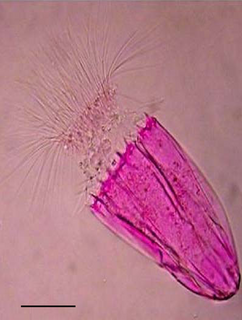 W
WLoricifera is a phylum of very small to microscopic marine cycloneuralian sediment-dwelling animals with 37 described species, in nine genera. Aside from these described species, there are approximately 100 more that have been collected and not yet described. Their sizes range from 100 μm to ca. 1 mm. They are characterised by a protective outer case called a lorica and their habitat is in the spaces between marine gravel to which they attach themselves. The phylum was discovered in 1983 by Reinhardt Kristensen, in Roscoff, France. They are among the most recently discovered groups of Metazoans. They attach themselves quite firmly to the substrate, and hence remained undiscovered for so long. The first specimen was collected in the 1970s, and later described in 1983. They are found at all depths, in different sediment types, and in all latitudes.
 W
WLoricifera is a phylum of very small to microscopic marine cycloneuralian sediment-dwelling animals with 37 described species, in nine genera. Aside from these described species, there are approximately 100 more that have been collected and not yet described. Their sizes range from 100 μm to ca. 1 mm. They are characterised by a protective outer case called a lorica and their habitat is in the spaces between marine gravel to which they attach themselves. The phylum was discovered in 1983 by Reinhardt Kristensen, in Roscoff, France. They are among the most recently discovered groups of Metazoans. They attach themselves quite firmly to the substrate, and hence remained undiscovered for so long. The first specimen was collected in the 1970s, and later described in 1983. They are found at all depths, in different sediment types, and in all latitudes.
 W
WLoricifera is a phylum of very small to microscopic marine cycloneuralian sediment-dwelling animals with 37 described species, in nine genera. Aside from these described species, there are approximately 100 more that have been collected and not yet described. Their sizes range from 100 μm to ca. 1 mm. They are characterised by a protective outer case called a lorica and their habitat is in the spaces between marine gravel to which they attach themselves. The phylum was discovered in 1983 by Reinhardt Kristensen, in Roscoff, France. They are among the most recently discovered groups of Metazoans. They attach themselves quite firmly to the substrate, and hence remained undiscovered for so long. The first specimen was collected in the 1970s, and later described in 1983. They are found at all depths, in different sediment types, and in all latitudes.
 W
WPliciloricidae are a family of marine organisms in the phylum Loricifera. It contains 22 species in 3 genera.
 W
WPliciloricus is a genus of marine organisms Pliciloricidae family, the phylum Loricifera described by Higgins & Kristensen, 1986.
 W
WPliciloricus enigmaticus is a marine Loriciferan species of genus Pliciloricus described by Higgins & Kristensen 1986.
 W
WSpinoloricus is a genus of nanaloricid loriciferans. Its type species is S. turbatio, described in 2007, and another species, native to completely anoxic environment, Spinoloricus cinziae, was described in 2014.
 W
WSpinoloricus cinziae is an animal species described in 2014 in the phylum Loricifera.
 W
WTitaniloricus is a genus of small marine animal in the phylum Loricifera. It contains a single species, Titaniloricus inexpectatovus, described by Gunnar Gad in 2005. It has been collected from the abyssal plain in Angolan waters of the Atlantic Ocean.